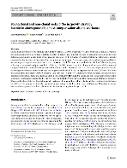Young clonal and non-clonal herbs differ in growth strategy but not in aboveground biomass compensation after disturbance

Publication date
2020Published in
OecologiaVolume / Issue
193 (4)ISBN / ISSN
ISSN: 0029-8549Metadata
Show full item recordCollections
This publication has a published version with DOI 10.1007/s00442-020-04724-7
Abstract
Clonal plants have more traits enabling individual persistence (larger belowground storage of buds and assimilates), whereas non-clonal plants have more traits enabling population persistence (a higher reliance on regeneration from seeds). This difference presumably makes those groups respond differently to disturbance. We asked whether this difference is already expressed in the first year of the plant's life. In a pot experiment with 17 congeneric pairs of clonal and non-clonal herbs, we investigated response to a disturbance at the individual level. We were interested whether the leaf C/N ratio (a proxy reflecting active growth and photosynthetic efficiency), the R/S ratio (a proxy for belowground storage) and the amount of compensated biomass differ between clonal and non-clonal herbs. Moreover, we asked whether compensation for the loss of aboveground biomass after disturbance can be predicted by the R/S ratio or explained by the leaf C/N ratio. We found that clonal herbs have higher leaf C/N and R/S ratios than non-clonal herbs. Under disturbance, the leaf C/N and R/S ratios decreased in the clonal herbs and increased in the non-clonal herbs. However, the clonal and non-clonal plants did not differ in biomass compensation ability. Neither the R/S ratio nor the leaf C/N ratio explained the compensation abilities of the herbs. These results show that even though the growth strategies of clonal and non-clonal plants and their reactions to disturbance are different, the groups are similarly capable of compensating for the loss of aboveground biomass. Clonal plants do not have an advantage over non-clonal plants under disturbance during their first year of life.
Keywords
Bud, C, N ratio, Growth, R, S ratio, Strategy
Permanent link
https://hdl.handle.net/20.500.14178/1655License
Full text of this result is licensed under: Creative Commons Uveďte původ 4.0 International







